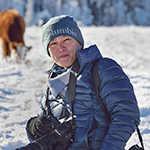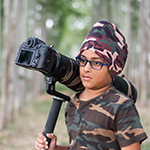
winners gallery 2018
GRAND PRIZE

Wishful Love
Nanchang, China
By Xu Yong
Shanghai, China
Camera: Canon EOS-1D X; Canon EF600mm f/4L IS II USM; 1/1250 sec; f/5.6; ISO 200.
Lumix Award
Story: In Sri Lanka before the colonial period there were 40,000 Sri Lankan elephants. Due to overhunting during the colonial period that number has been
drastically reduced down to about 5,000. However poaching still continues. The Sri Lankan elephant has a tragic history but on one eve-ning last summer I has able to take this photo of a parent and child in a heard. When I saw this
scene I thought, “humans should not disturb them anymore”. This was a lovely scene filled with peace and affection.
Camera: Fujifilm X-T2; Fujifilm XF 100-400mm F4.5-5.6 R LM OIS WR; 1/500 sec; ƒ/5.6; ISO 800.
Sigma Award

Harmony
Qinling, China
By Kuanliang Ding
Xi’an, China
Camera: Nikon D800; Nikon AF-S NIK-KOR 600mm f/4E FL ED VR; 1/1000 sec; f/4.0; ISO 560; Gitzo GT3532
Wildlife
WINNER WILDLIFE

Father and His Young One
Son Tra Nature Reserve, Vietnam
By Tatsuya Okuda
Tokyo, Japan
Camera: Canon EOS 7D Mark II; Canon EF600mm f/4L IS II USM; 1/1000 sec; ƒ/5.0 ISO 500; Gitzo GT3542L.
HIGHLY HONORED WILDLIFE
Story: Hanuman langurs are the best subjects to capture especially when accompanied by baby langurs.I always wanted to capture a mother and baby langur relationship in the wild. I have always been curious how they behave and I got the opportunity to take this image at Pench National Park while waiting for alarm calls. It is pretty difficult to capture them as they keep on moving and jumping every second. I have made several failed attempts to capture an image of a baby on its mother’s lap. After so many failed attempts when I heard the alarm call of a sambar deer suddenly the baby langur went straight to it’s mothers lap and started suckling. I made no mistake in capturing it in the best possible way. A wait of almost one hour had paid off.Capturing emotion in the eyes of the mother and baby was a very difficult task in such low light with an overcast sky.Camera:Nikon D5; Nikon AF-S NIKKOR 600mm f/4E FL ED VR; 1/8000 sec; f/4.0; ISO 6400.
HIGHLY HONORED WILDLIFE
Story:The Noge peninsula in Hokkaido is a paradise where various wild animals live. On this day, I was able to capture these two northern foxes. Who won or lost this fight was deter-mined by comparing the size of their mouths this way they could avoid a real physical conflict. This is an important behavior to keep good relationships between foxes. When the game was over they parted ways. It was a freezing day where the cold of winter still remained but I was lucky to see this heartwarm-ing scene.Camera: Sony A7R3; Sony FE 24-70mm f/2.8 GM; 1/400 sec; f/6.3; ISO 100.
HIGHLY HONORED WILDLIFE

I Watched in Awe
Sekoyner River, Tanjung Putting, National Park, Kalimantan,Indonesia
By Jayaprakash Bojan
Singapore
Photographer's Website
Camera:Canon 5D Mark IV; Canon EF 100-400mm f/4.5-5.6L IS II USM; 1/2000 sec; f/5.0; ISO 1250.
HIGHLY HONORED WILDLIFE
Story:This is a photo of a Mediterranean chameleon on a Paulow-nia fortunei branch on a sun-drenched day at noon. The photo shows its prehensile tail, which assists it in cling-ing to branches, and one of its cone-shaped eyes. Chameleons can move their eyes separately and look in opposite directions simultaneously, which accords them a unique vision capacity. When a chameleon locates its prey with one eye, it moves its head in the direction of its prey, directs both eyes, and then sees its exact location.Camera: Canon EOS 1200D; Canon EF 100mm f/2.8 Macro USM; 1/250 sec; f/9.0; ISO 400.
HIGHLY HONORED WILDLIFE
Story: Kamchatka is stunning-ly rich in unexploited natural resources and natural beauty. To me animals always look more graceful in their natu-ral habitat than a close up image, I also believe the background is very important for any photo along with a proper level to get a real feel of the scenic beauty. As you can see in this photo the whole habitat compliments each other and hence I call it “In Paradise”.Camera:Nikon D4; AF-S NIKKOR 70-200mm f/2.8G ED VR II; 1/64 sec; f/3.2; ISO 6400.
LANDSCAPE
WINNER LANDSCAPE

Heaven of Rocks
Pegadungan Beach, Indonesia
By Gunarto Song
Jakarta, Indonesia
Photographer's Website
Camera:Canon EOS 5DS R; Canon EF 11-24mm f/4L USM; 1 sec; ƒ/16; ISO 50.
HIGHLY HONORED LANDSCAPE
Story:On a sunny winter day while driving through a forest in Yamanashi Prefecture I came upon an open space where I could see Mt. Fuji. Strange shaped clouds were gathering and flowing over the summit of Mt. Fuji. It was a very impressive and unusual site. I photographed it by using a long exposure and converted it to black and white. It is a very wonderful and impressive photograph and makes me feel as if I were on another planet. It was an amazing and wonderful scene of nature.Camera:Nikon D800; Nikon 24-120mm f/4G ED VR AF-S; 242 seconds; ƒ/8.0; ISO 100.
HIGHLY HONORED LANDSCAPE
Story: Yufu River Gorge is a 15 to 60 meter deep canyon that has been eroded by the Yufu River. The face of the canyon walls are smooth rock and the area has a total of 40 water-falls creating a unique landscape. The day I took this photo the rain that had started in the morning caused the Yufu River to rise. The usually thin small waterfalls also gained momentum be-cause of the rain and I was blessed with a scene I could probably have never seen. In order to capture the flow of the dark rocky canyon walls and the bright soft waterfalls, I carefully setup my tripod in the middle of the flowing river.Camera: Canon EOS-1Ds Mark III; Canon EF 24-70mm f/4L IS USM; 15 secs; f/11; ISO 100.
HIGHLY HONORED LANDSCAPE
Story: Lake Baikal is the oldest and deepest lake in the world. During winter especially in February and March, the lake’s surface is frozen solid and becomes the main sighseeing site in the Irkust region. The extraor-dinarily pure and transparent surface of the frozen lake makes it a landscape photographers paradise. For this photo, my friends and I encountered subzero temperatures. Since it was snowing the night before, most of the lake was covered by snow however we managed to find an area with transparent ice on the surface where bubbles of methane gas can be seen below the surface of the frozen lake. I positioned my camera at a low angle and pointed it up toward the rock, I managed to get a few shots as the sun rose above the lake casting its golden light upon the lake.Camera: Fujifilm X-T2; Fujifilm XF 10-24mm f/4 R OIS; 1/60 sec; f/11; ISO 400.
HIGHLY HONORED LANDSCAPE

Mt. Bromo’s Eruption
Mt. Bromo, Indonesia
By Riksa Dewantara
Surabaya, Indonesia
Photographer's Website
Camera: Leica M240; Leica Super Elmar 21mm; 0.7 seconds; f/16; ISO 200.
HIGHLY HONORED LANDSCAPE
Story:The Kumtag Desert is located in Xinjiang, China. We set off in the winter to shoot in the desert. The desert surface in the morning was covered with a thin layer of frost. The combination of smooth lines is very beautiful. The natural light shines on the desert and presents rich layers. This was a fantastic scene that I shot with a middle telephoto lens, of which I was very happy to have captured.Camera: Nikon D4; AF-S NIKKOR 70-200mm f/2.8G ED VR II; 1/100 sec; f/10; ISO 250.
OCEAN
WINNER OCEAN
Story: Rhinopias is a type of scorpionfish fish that doesn’t move often and stays in place waiting for food. It was hiding under a red sea fan and it looked like it was on fire. It was very beautiful and gorgeous. I used a snoot on the flash to shoot this photo.Camera: Canon EOS-1D X Mark II; Canon EF 24-70mm f/4L IS USM; 1/250 sec; f/18; ISO 400; Seacam Seaflash Offshore 150O TTL.
HIGHLY HONORED OCEAN
Story: I am a diving guide in Izu, Japan. Uni-corn shrimp are usually distributed at depths of between 200 and 300 meters but will lay their eggs at a depth of up to 40 meters. The number of shrimp varies from year to year, but it ranges from hundreds to tens of thousands. They do not like bright places so they usually hide in rock shadows, but in years where there are many of them they cover the ocean floor since there is a lack of rock shadows. I cropped this photo to show a beautiful alignment of shrimp.Camera:Canon EOS 5Ds R; Sigma Macro 50mm F2.8 EX DG; 1/160 sec; f/18; ISO 400.
HIGHLY HONORED OCEAN
Story: A chrysaora pacifica and small fish. In the early morning of a winter day, while wearing a dry suit and holding the camera as usual, I scuba dived leisurely in the sea. I usually dive with a macro lens attached. The ocean had been very beautiful for the past few days and deep-sea fish and deep-sea creatures appeared due to up-welling so I expected to see something so I went in to the ocean with a wide angle lens. On this day I was able to see many unique creatures that I can not usually see but the encounter with this jellyfish was especially interesting. A lot of small fish were around the jellyfish and I took many photos of it. I was excited to cross paths with another chrysaora pacifica.Camera:Canon EOS 5D Mark II; Sigma 15mm f/2.8 EX DG Diagonal Fisheye; 1/100 sec; f/8.0; ISO 400; Inon Z-240 Strobe.
HIGHLY HONORED OCEAN
Story:It has been 26 years since I first swam with dolphins in the beautiful sea of Bonin Blue. Bonin Blue is a special word used to describe the color of the ocean around Ogasawara. I still swim with dolphins whenever I have the chance. I never get tired of it and I could continue swimming with dolphins for another five or ten years capturing them with my camera. One day in the spring when I was on one of my daily dives I met a pod of baby dolphins. My eyes met with the sweet eyes of a baby dolphin whose body was still white. It was as if its lovely eyes were inviting me into the sea.Camera: Canon EOS 5D Mark II; Canon EF 16-35mm f 2.8L; 1/320 sec; f/6.3; ISO 400.
HIGHLY HONORED OCEAN
Story: Baa Atoll in the Mal-dives is a famous place for the hordes of mantas that visit to feed on plankton.On this day I encountered a group of mantas much larger than I had expected. From the way they were swim-ming, it seems that they were not at all worried about the presence of humans. A group of mantas were spiraling up-ward and I was able to capture the mo-ment the leader of the group reached the surface flipped his body over and dove back down. This photo truly expresses the mantas’ suppleness and strength.Camera:Nikon D800; Sigma 15mm f/2.8 EX DG Diagonal Fisheye; 1/160 sec; f/8.0; ISO 500.
HIGHLY HONORED OCEAN
Story: Dugongs eat algae at the bottom of the sea. Dugongs have nostrils on their snouts. These nostrils have special valves that are closed under the water surface and open when they return to the water surface to breath. Dugongs may remain under water for around 6 minutes.Camera: Sony DSC-RX100M5; Sony Vario-Tessar T* FE 24-70mm f/4 ZA OSS; 1/250sec; f/10; ISO 250.
SMALL WORLD
WINNER SMALL WORLD
Story: This type of red ant is a common insect in Thailand and very tough on any prey no matter how big it is. When I was searching for insects to shoot in the grass and bushes, I found this little gecko’s tail being bitten and held tightly by the red ant. The ant was trying to pull the gecko off from the leaf, I quickly focused on it and clicked the shutter to catch this moment, after struggling desperately for a few seconds the gecko was able get rid of the ant and run away.Camera: Canon EOS 5Ds R; Canon EF 100mm f/2.8 Macro USM; 1/400 sec; ƒ/5.6; ISO 400.
HIGHLY HONORED SMALL WORLD
Story: Weaver Ants (Oecophylla smaragdina) are known for their hard work and cooperation. These ants exhibit marvelous architecture and intelligence to build their nest with leaves. When a new nest is required, individual workers scout for suitable clusters of leaves, which they grab with their mandibles and attempt to draw together. When a number of leaves are stretched into position for binding, each held in place by rows of workers joined by another set of workers as is depicted in the picture. As soon as all the leaves are brought together the process of stitching these leaves starts. The mature and experienced workers capture white colored and transparent late instar larvae with quite delicacy in their mandibles and move them to and fro on the edges of the young tender leaves. In response to this movement or tingling feeling, the larvae release sticky material from their glands and a white sheet of silk joins the leaves one by one. This behavioral characteristic of ‘stitching or weaving leaves’ for nest formation is unique among these ants, and the reason behind their name ‘Weaver Ants’.Camera: Nikon D90; Nikon AF-S VR Mi-cro-NIKKOR 105mm f/2.8G IF-ED; 1/125sec; f/16; ISO 200; Nikon R1C1 Unit Flash.
HIGHLY HONORED SMALL WORLD
Story: This is a group of Shi-nano Tomoshibi mushrooms; Scientific name: Mycena lux-coeli. These glowing mushroom can only be seen in several places in Japan and in the entire world. They only grow for a short time around the end of June. Since I wanted to show this bunch of mushrooms like family living in the hollow of a tree I shot this photo in the middle of the night just using the light of the mushrooms. It was raining a little. This group of mushrooms were shining for only a few days and withered the next day. My history of photograph is long and I have taken many photographs of the starry sky. About 8 years ago I started taking pictures of natural glowing things such as fireflies and sea fireflies at night.Camera: Canon EOS 6D; Zeiss Macro-Planner 50mmF2; 240 seconds; f/8.0; ISO 1600; Gitzo GT5562LTS.
HIGHLY HONORED SMALL WORLD

Paralyzed Moment
Coimbatore, India
By Karthikeyan Shanmugasundaram
Coimbatore, India
Photographer's Website
Camera: Canon EOS 5D Mark III; Sigma 105mm f/2.8 EX DG OS HSM; 1/200 sec; f/11; ISO 400; Canon Speedlite 430EX II.
HIGHLY HONORED SMALL WORLD

Rolling Stones
Yala National Park, Sri Lanka
By Asela Karunaratne
Kurunegala, Sri Lanka
Photographer's Website
Camera: Nikon D4S; Sigma 105mm f/2.8 EX DG OS HSM; 1/600 sec; f/7.1; ISO 1250; Nikon SB900 flash.
HIGHLY HONORED SMALL WORLD
Story: It was late night by the time the rain had stopped, I went to the field and there I found this gecko sitting on top of a rock. After a few clicks I finally got a decent shot. Most Geckos can’t blink as they don’t have eyelids. Like snakes, their eyeballs are covered with spectacles and transparent scales that protect the eyes. To keep them clean, many species use their tongues like windshield wipers. They also drink water in a similar way. I clicked this image with the help of 50mm f/1.8 along with attaching a Voking 12mm extension tube.Camera: : Nikon D500; Nikon AF-S Nikkor 50mm f/1.8G & Voking 12mm Extension tube; 1/250sec; f/8.0; ISO 50.
BIRDS
WINNER BIRDS
Story: A baby grey heron is slowly trying to reach his nest after becoming separated from it and starting to feel unsafe. This photo of the baby heron was taken on Bubiyan Island, the largest island in the Kuwaiti coastal island chain situated in the north-western corner of the Arabian Gulf. It is a safe place for both animals and people alike. To reach the island you need to have government permission and has been an environmentally protected area for more than 27 years. When I got to the island I found some nests then lay down and moved around slowly while wearing my camouflage clothing.Camera: Canon EOS-1D X Mark II; Canon EF 100-400mm f/4.5-5.6L IS II; 1/3200 sec; f/5.6; ISO 800.
HIGHLY HONORED BIRDS

Beak Full of Fruit
Galle, Sri Lanka
By Sunil Warnakulasuriya
Moratuwa, Sri Lanka
Camera: Nikon D 5100; Nikon DX-AFS NIKKOR 55-300mm 4.5-5.6 G ED; 1/1250 sec; f/5.0; ISO 2000; Digipod TR-654.
HIGHLY HONORED BIRDS
Story: I took a picture of this pharaoh eagle owl chick in the northern Kuwaiti desert, 160 km away from Kuwait City. He was hiding between these yellow small bushes while one of his parents was giving an alarm call since I was kind of close to the chick. I parked the car far away and walked slowly to a spot where I lie down and put a net over me and waited for the parent to catch something and feed the chick. I stayed there for almost three hours and I was sweating all over because of the high temperature - it was about 49 degrees - so I waited and nothing happened then a breeze of air started to hit the yellow grass. Then the chick stood up and started looking around. Because I was on the ground at eye level, this blur effect came out perfect.Camera: Canon EOS-1D X; Canon EF 500mm F/4L IS II USM; 1/2500 sec; f/7.1; ISO 800.
HIGHLY HONORED BIRDS
Story: This beautiful little bird is a vernal hanging parrot, it is the only parrot in India, all of the other birds in the parrot family are parakeets. It was January, mid winter in Goa. Not that cold in this part of the world. Good season for birding and bird photography though. On one of my visits to this area, I kept observing that these parrots regularly visit the plant of powder-puff flowers, in the morning and afternoon, almost everyday. These birds seem to love powder-puff flowers. So, one afternoon, I found a spot to sit and wait for them to arrive. Didn’t have my tripod with me unfortunately. So, I had to make do hand-holding the big and heavy 500 f/4 lens. After a long wait, they finally showed up. Landing on the plant, they started feeding on the lovely pink flowers giving some opportunities to make a few images. I had to juggle around with the ISO combinations to get a decent enough shutter-speed to hand hold. All the effort and the wait was absolutely worth it.Camera: Nikon D500; Nikon AF-S NIK-KOR 500mm f/4E FL ED VR; 1/3000 sec; f/4.0; ISO 1100.
JUNIOR
WINNER JUNIOR
Story: I often travel to Kapurthala town with my father for birding. In winter on a Sunday morning I also went with my father once again for bird photography. On the way while we were crossing the road I saw a spot-ted owlet flying and he went inside this tube. I asked my dad to stop the car, he stopped the car but didn’t believe me that the owl could go inside this tube. I looked at the tube again for few minutes and I was surprised to see a pair of owlets coming out of the tube. I pointed my dad towards the tube and he was stunned seeing the owls over there. He rolled the car glass down for me and without wasting anytime I got the shot of the owlet duo. They were looking straight into my eyes, I felt like each of the owlets wanted to say “I C U” boy! I was happy to see these beautiful spotted owlets in their urban home and I had to say goodbye to them so that they could be on their own.Camera: Nikon D500; AF-S NIKKOR 500MM F/4E FL ED VR; 1/1600 sec; f/4.0; ISO 450.
HIGHLY HONORED JUNIOR
Story: A school of yellow fusilier fish swam around the camera, encompassing me in a living wave. I had just started taking underwater photos, and I was looking for scenes that cap-ture the essence of diving for me, when I noticed this school of fish swimming with the current a bit further down the reef from me. I positioned myself in their path, and waited for the current to bring them closer. I was hoping that they would swim around me and create a tunnel effect so I could take a photo. When they approached, I angled myself so that I would take up less space and aimed my camera directly into the school. I was absolutely ecstatic when the wave broke into a tunnel, and swam around me. This photo was taken in the Malé atoll in the Maldives, which is one of the countries that is most threatened by rising sea levels (as a result of global warming).Camera: Canon PowerShot G7 X Mark II; 1/320 sec; f/4.0; ISO 200.
HIGHLY HONORED JUNIOR
Story: A green turtle swims by the camera, showing off the unique pattern on the side of his face and shell. I had just started using my underwater camera, when I began my PADI Sea Turtle Identification specialization course. The course is geared towards the protection and conservation of sea turtles by taking photos of the side of a sea turtle’s face. This pattern is unique to an individual, similar to how each person’s thumbprint is unique to them. By keeping track of all of the turtles in the reef, it is possible to know what turtles are unhealthy or at risk so they can take measures to protect them. During the dive, we were supposed to swim close enough to a turtle to capture the pattern on their face, and record it for later. This photo shows the turtle’s face clearly and the health of the turtle can be assessed from the body. This photo was taken in Malé atoll in the Maldives.Canon PowerShot G7 X Mark II; 1/800 sec; f/2.2; ISO 250.
HIGHLY HONORED JUNIOR

Tibetan Wild Ass (Kiang)
Hanle, Ladakh, India
By Dheeraj Nanda
Bangalore, India
Photographer's Website
Camera: Canon EOS 7D Mark II; Canon EF100-400mm f/4.5-5.6L IS II USM; 1/400 sec; f/5.6; ISO 640.
HIGHLY HONORED JUNIOR
Story:I was waiting to see an eagle on the summit of the mountain for 5 days. Sometimes it would appear but it would soon disappear. Then there was this deer that appeared on the rocks where the eagle often lands. Small deer are sometimes caught by eagles but this deer has a splendid set of antlers and appeared in a spot where it had no fear of being attacked. The angle of the backlit deer made for a very impressive scene. The deer moved before I could change the settings on my camera, so it came out a bit brighter than what I had intended, but I manipulated the image to match the way I remember seeing it.Camera: Nikon D7100; AF-S NIKKOR 200-500mm f/5.6E ED VR; 1/1000 sec; f/8.0; ISO 800.
HIGHLY HONORED JUNIOR
Story: Ezomon monga or flying squirrel is a nocturnal animal, except for when it is mating. Because it does not usually come out during the day, I waited three months for the mating season and was finally able to take this shot. This was taken in March when the weather is often freezing and causes very cold fingers. The ezomon monga is an important subject and has been a big turning point in my experience as a photographer.Camera: Canon EOS 7D Mark II; Tamron SP 150-600mm F/5-6.3 Di VC USD; 1/100 sec; f/8.0; ISO 800.
VIDEO
VIDEO WINNER

Wildlife of My Beautiful Village
Tsurui, Japan
By Makoto Ando
Hokkaido, Japan
Photographer's Website
Camera: Nikon D850; Nikon AF-S NIK-KOR 400mm f/2.8E FL ED VR
Video Highly Honored
Story: Shiretoko Peninsula-Hokkaido. Every year in winter, eagles come across the sea with the ice floes from Siberia. Also crossing the sea from all over the world to see such a valiant sight are people. I am one of them. We meet again as if we promised. Whether we can meet again next year, neither them nor myself will know for sure. But surely they will come again. Aging, with feathers urning white the eagle’s lifetime is long, and I want to continue this invisible promise with nature and these animals as my hair turns white as well.Camera: Panasonic Lumix DC-GH5S; Leica DG VARIO-ELMAR 100-400mm/F4.0-6.3, Lumix G X VARIO 35-100mm/F2.8.
Video Highly Honored

Wild Dolphins of Bonin
Island Ogasawara Islands, Japan
By Mana Nomoto
Ogasawara, Japan
Photographer's Website
Camera: Sony FDR-X3000R/W; GoPro HERO5 Black, Canon EOS 5D Mark II, Canon EF16-35mm F2.8L II USM, Zillion ZAP hous-ing.
Video Highly Honored
Story: Almost every year the barren beaches of Rushikulya come alive with the beating of the heavy flip-pers of hundreds of thousands of Olive Ridley Sea Turtles who come en-masse to nest adjacent to these coastal hamlets of Odisha, India. I had a dream to witness and photograph one of nature’s most extraordinary occurrences. I suc-ceeded this year. Arribada, the arrival, usually happens at night as the turtles cannot tolerate intense light. I wasn’t able to take the clippings (videos) at night as the conservation rules imple-mented by the forest department didn’t allow the use of white beam of torches (flashlights). The low red beam of the headlamp was the only permissible light source at night, so the arriving turtles won’t feel disturbed. I chose dusk and dawn to photograph to at least get the minimum light required. I found it toughest to keep the focus sharp when the turtles were moving. I overcame this with a trick - of pre-focusing a wide zone initially and switching the focus to manual to avoid lens hunt and to shoot the clippings (video) handheld.Camera: Nikon D7200; Nikon AF-S DX Nikkor 18-140mm F/3.5-5.6 G ED VR.
Video Highly Honored

Battle of Survival
Kolhapur, Western Ghat, India
By Dhananjay Jadhav
Maharashatra, India
Photographer's Website











-Levisman.jpg)

















































_low-res_small.jpg)






